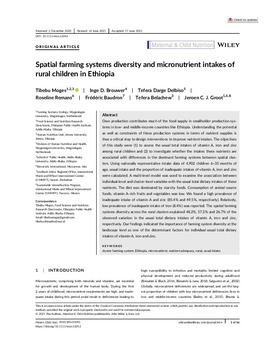Mostrar el registro sencillo del ítem
Spatial farming systems diversity and micronutrient intakes of rural children in Ethiopia
| Creador: | Moges, T. |
| Creador: | Brouwer, I.D. |
| Creador: | Delbiso, T.D. |
| Creador: | Remans, R. |
| Creador: | Baudron, F. |
| Creador: | Belachew, T. |
| Creador: | Groot, J.C.J. |
| Año: | 2022 |
| URI: | https://hdl.handle.net/10883/21591 |
| Lenguaje: | English |
| Editor: | Wiley |
| Copyright: | CIMMYT manages Intellectual Assets as International Public Goods. The user is free to download, print, store and share this work. In case you want to translate or create any other derivative work and share or distribute such translation/derivative work, please contact CIMMYT-Knowledge-Center@cgiar.org indicating the work you want to use and the kind of use you intend; CIMMYT will contact you with the suitable license for that purpose |
| Tipo: | Article |
| País de enfoque: | Ethiopia |
| Lugar de publicación: | Untied Kingdom |
| Número: | 1 |
| Volumen: | 18 |
| DOI: | 10.1111/mcn.13242 |
| Palabras Claves: | Cluster Farming System |
| Palabras Claves: | Micronutrients |
| Palabras Claves: | Nutrient Adequacy |
| Palabras Claves: | Usual Intake |
| Descripción: | Own production contributes much of the food supply in smallholder production systems in low- and middle-income countries like Ethiopia. Understanding the potential as well as constraints of these production systems in terms of nutrient supplies is thus a critical step to design interventions to improve nutrient intakes. The objectives of this study were (1) to assess the usual total intakes of vitamin A, iron and zinc among rural children and (2) to investigate whether the intakes these nutrients are associated with differences in the dominant farming systems between spatial clusters. Using nationally representative intake data of 4,902 children 6–35 months of age, usual intake and the proportion of inadequate intakes of vitamin A, iron and zinc were calculated. A multi-level model was used to examine the association between individual-level and cluster-level variables with the usual total dietary intakes of these nutrients. The diet was dominated by starchy foods. Consumption of animal source foods, vitamin A-rich fruits and vegetables was low. We found a high prevalence of inadequate intake of vitamin A and zinc (85.4% and 49.5%, respectively). Relatively, low prevalence of inadequate intake of iron (8.4%) was reported. The spatial farming systems diversity across the rural clusters explained 48.2%, 57.2% and 26.7% of the observed variation in the usual total dietary intakes of vitamin A, iron and zinc, respectively. Our findings indicated the importance of farming system diversity at the landscape level as one of the determinant factors for individual usual total dietary intakes of vitamin A, iron and zinc. |
| Agrovoc: | FARMING SYSTEMS |
| Agrovoc: | TRACE ELEMENTS |
| Agrovoc: | NUTRIENTS |
| Agrovoc: | RURAL AREAS |
| Agrovoc: | NUTRIENT INTAKE |
| Elocator: | e13242 |
| ISSN: | 1740-8695 |
| Revista: | Maternal and Child Nutrition |
Ficheros en el ítem
Este ítem aparece en la(s) siguiente(s) colección(ones)
-
Sustainable Intensification
Sustainable intensification agriculture including topics on cropping systems, agronomy, soil, mechanization, precision agriculture, etc.

